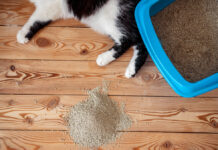Quick Emergency Action Steps:
- Stay calm (your dog can sense your panic!)
- Check if the stick was eaten
- Note the type of lollipop
- Call your vet ASAP if xylitol is involved
Hey fellow pet parents! Today I’m gonna share something that happened to me last week – my curious furball decided to snatch a lollipop right off my coffee table! Talk about giving me a heart attack! If you’re reading this in panic mode cause your dog just did the same thing, let’s walk through this together.
The Real Dangers When Dogs Eat Lollipops
1. The Lollipop Stick – Your Biggest Worry
Let’s be real – the stick is probably what’s making you freak out right now. Here’s the deal – Wooden sticks can splinter and cause internal damage- Plastic sticks might cause blockages- Paper sticks are less dangerous but still not ideal
2. The Sweet Stuff – What’s Actually in That Candy?
Regular Sugar
Good news! Plain sugar isn’t toxic to dogs. Your pup might get – An upset tummy- The zoomies from the sugar rush- Maybe some diarrhea (ugh not fun!)
But it’s not usually life-threatening
The REAL Danger: Xylitol
This is where things get serious, fam. If that lollipop contained xylitol (an artificial sweetener), you need to:- Call your vet immediately- Watch for symptoms like: * Vomiting * Weakness * Difficulty standing * Seizures
What to Do Right Now (Like, Seriously, Right Now)
Step 1: Don’t Panic (But Act Fast)
Take a deep breath. Your quick action matters more than freaking out!
Step 2: Detective Work
- Find any wrapper pieces
- Look for the stick
- Check what kind of lollipop it was
- Count how many were eaten
Step 3: Monitor Your Dog
Keep an eye out for:- Choking signs- Vomiting- Changes in behavior- Difficulty pooping- Loss of appetite
When to Call the Vet ASAP
Call your vet immediately if:1. Your dog ate a sugar-free lollipop2. You can’t find the stick3. Your dog is showing any unusual symptoms4. They ate multiple lollipops
Prevention Tips (Cause We Learn from Our Mistakes!)
- Keep All Candy Up High
- Use sealed containers
- Store in closed cabinets
- Never leave candy on low tables
- Train Your Dog
- “Leave it” command is super helpful
- Reward good behavior
- Be consistent with rules
- Be Extra Careful During Holidays
- Halloween is especially risky
- Watch those Christmas stockings
- Easter baskets are tempting!
The Long-Term Watch
24 Hours After Incident:
Watch for:- Normal eating habits- Regular bathroom routine- Typical energy levels
48-72 Hours After:
Look for:- Normal poop (yeah, you gotta check!)- Usual playing behavior- Regular appetite
My Personal Experience
Y’all, when my Lab mix, Bruno, grabbed that cherry lollipop, I legit thought I was gonna lose it! But staying calm helped me think straight. I checked the wrapper (thank goodness it wasn’t sugar-free), found the stick on the floor (phew!), and kept an eye on him. He was totally fine, just had some really interesting colored poop the next day!
Common FAQs (Cause I Know You’re Wondering)
Q: Will one lollipop kill my dog?
A: Usually not, unless it contains xylitol. Regular sugar lollipops typically just cause temporary tummy troubles.
Q: How long should I watch my dog after eating a lollipop?
A: At least 24-48 hours for regular lollipops, but call vet immediately for sugar-free ones.
Q: What if I can’t find the stick?
A: Monitor closely for signs of blockage and contact your vet for guidance.
The Bottom Line
Look, accidents happen – we’re all human! The key is knowing what to do when our furry friends get into things they shouldn’t. Most times, a regular lollipop incident ends up being more scary than dangerous. But always better safe than sorry, right?
Remember:- Regular sugar = usually just tummy troubles- Xylitol = emergency vet visit- Missing stick = close monitoring- When in doubt, call your vet!
Keep those sweets out of reach, and maybe stick to dog treats instead of lollipops! Trust me, your pup (and your stress levels) will thank you later!
Stay safe, pet parents! And if you’ve got a similar story, drop it in the comments – we’re all in this together!
Disclaimer: While this article is based on research and experience, always consult your veterinarian for professional medical advice about your pet’s specific situation.










![Can Dogs Have Surimi? The Truth About Feeding Imitation Crab to Your Furry Friend Can Dogs Eat Imitation Crab? [MUST KNOW FACTS!!]](https://petlikeboss.com/wp-content/uploads/2024/11/Can-Dogs-Eat-Sushi-Rice-2-100x70.jpg)

